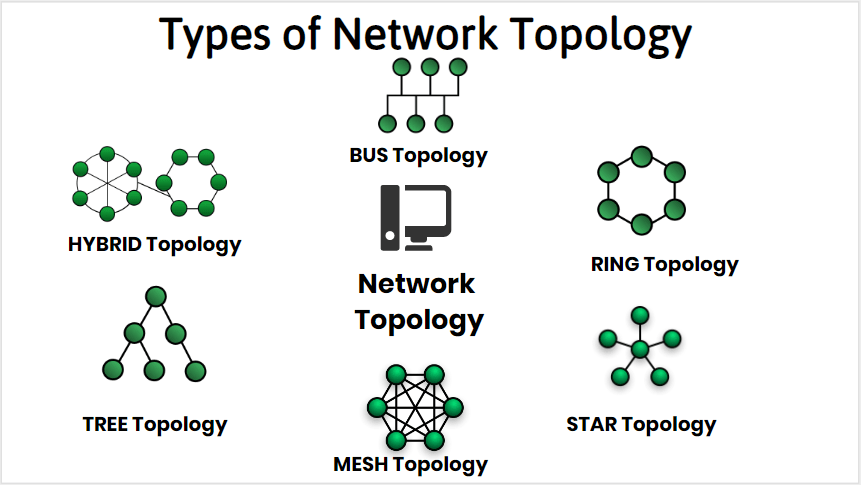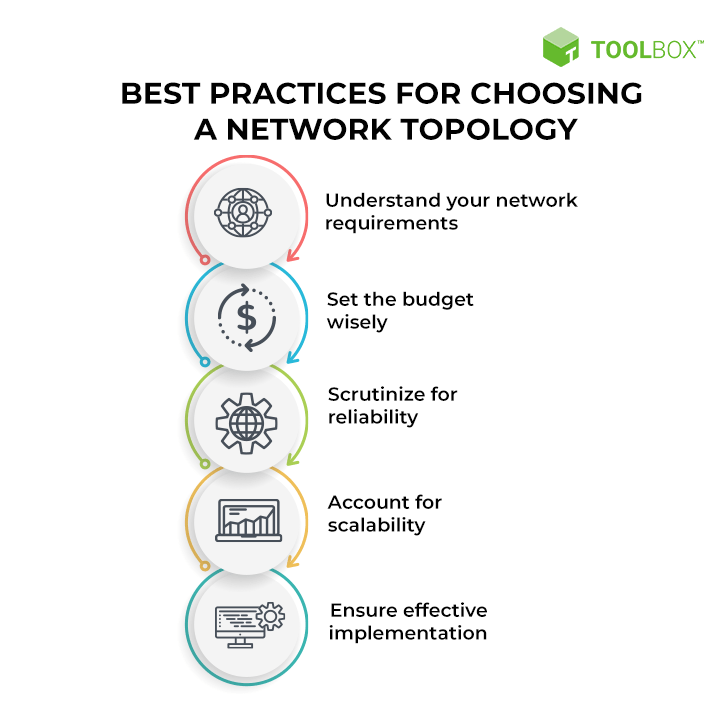A fast and reliable network demands effective interconnection between the devices. The way your network devices communicate depends on the topology of your network. This article will explain network topology, its types, and best practices.

Contents
- 1 What is the Network Topology?
- 2 Why is Network Topology Important?
- 3 Types of Topologies:
- 4 How to design a network topology?
- 5 How to Check the Best Topology for Your Network?
- 6 Pros and cons of network topology
- 7 What Tools Help Manage and Monitor Networks?
- 8 Best practices for selecting the ideal network topology for your organization
- 9 FAQs
What is the Network Topology?
Almost all businesses require an internal network. And without an effective network topology, you might not be as competent as you think. Let’s define network topology. A network topology in computer networks refers to the arrangement of your network devices; you can do this in many ways. There is the ring, bus, star, mesh, etc.
To understand the topology you need, you need to understand your network. That includes the speed and device requirements. Additionally, the topology must also be within your budget. Each topology has pros and cons. Ideally, your business must benefit from the pros, and the cons must be insignificant. For example, a mesh topology is expensive. But it would not matter to you if you have a high return on investment (ROI). And sometimes, you may only need point-to-point topology in a small area. So proper planning and research are necessary while designing a network topology for your business.
Why is Network Topology Important?
A network topology tells you where your network devices are in a complex network. It also enables you to predict their performance. Read on to understand a few other benefits of different types of topology in computer networks.
Easier for recruits
Recruits often have a difficult time understanding the network of the new workplace. A network topology can help them quickly know how your business network works.
Cost Reduction
By having a network topology, you can predict the network performance. That way, you can know what you need. And you can remove what you don’t require; it will lower your costs significantly.
Diagnostics
Finding a point of failure becomes straightforward with an efficient topology. You can also prevent failures as you monitor for network overload. Then you can allocate resources accordingly.
Types of Topologies:
There are the following types of network topology:
Point-to-point
This basic network topology has only two devices connected. Among the different types of topology, it is the fastest.
Star topology
Here, the network devices connect to a central hub. Data first flows to the network hub before reaching the destination.
Ring topology
In this topology, each device connects to two other devices. So data needs to pass through the intermediate nodes to reach the destination.
Bus topology
If you connect all the devices to a central network line, it is a bus topology. It is the slowest among the different network topologies.
Mesh topology
In Mesh topology, all the devices connect directly. That means the number of connections a device has depends on the total number of devices in the system.
Tree topology
Here, the devices in the network form a tree-like structure. Similar to the bus topology, it has a central network cable.

Source: Types of Network Topology
How to design a network topology?
The first step to constructing a network topology is to design it. You can use diagrams for that. It will tell your network admins what components to use.
To make a diagram, first, list all your network devices. That means routers, servers, hubs, etc. Then choose a network topology based on the requirement. Now you can start drawing the diagram. Draw the devices first, depending on the most efficient locations. Finally, show the network lines. Ensure the lines don’t cross too much, creating a messy design. This diagram should allow future modifications.
You can use network diagramming software to make a diagram quickly. These can be manual, automatic, or semi-automatic. Both automatic and semi-automatic software can detect your network. However, the automatic software also makes the diagram automatically. The manual version will give tools to place the devices quickly without drawing them.
How to Check the Best Topology for Your Network?
Several topology options are available, but choosing one shouldn’t be a conundrum if you set the right parameters for making a decision. It is also about acquiring awareness by conducting thorough research and even consulting experts to learn about possible options.
- Cable length – How much cable is used for setting up a network decides how much work it shall require for the setup. Mesh networks are labour-intensive and cable oriented. However, bus and star topologies are lightweight and have needless cable involvement.
- Cable type – Deciding what cable type is to be used has to be a conscious choice. The wiring selection would depend on the requirements of the network. Such details include the transmission distance, applications being used, performance goals, etc.
- Cost – The two basic costs involved are installation and operational costs. For instance, opting for optical fibre cables would be a poor choice if one has decided to go with the mesh topology setup. The key to finding the right match for your network is striking a justified balance between the operational and installation costs.
- Scalability – If a company has a long-term vision and would be interested in making amends for expansion, then choosing a flexible network topology would be best. In such a scenario, one should consider star topology as it gives you the liberty of altering, adding, or removal of nodes with less noise.
Pros and cons of network topology
Not all types of network topologies are equal. Each topology has a specific advantage that others don’t. Read on to understand them.
Point-point-topology
This basic network topology is simple to implement and has a superior bandwidth. However, you can not use it for networks with more than two nodes.
Bus topology
You require less cable for bus topology. However, this topology is slow, vulnerable to threats, increases bandwidth, and has data loss over long distances.
Ring topology
This topology has minimal packet collision, high speed, and can handle many nodes, and you can quickly troubleshoot it. However, a single failure can cause network disruption. And modifying the networks is challenging.
Star topology
A star topology requires low maintenance. Failures in devices won’t affect the network, and you can easily modify them. They are also fast. However, a fault in the hub disrupts the network.
Tree topology
The tree topology is flexible; you can modify it without disrupting the network. But a tree topology is complicated to build and tedious to manage.
Mesh topology
It is a highly efficient and secure topology. You can also identify the faults very quickly. However, it is costly, time-consuming, and requires many cables and IO ports. null
What Tools Help Manage and Monitor Networks?
Monitoring and management of networks do require certain network topology mapping products. Such software’s help you with the drawing aspects. Different software’s can cater for the needs of different topologies. The popular ones include Microsoft Visio, Lucidchart and LibreOffice Draw.
The two basic purposes of using such tools are network configurations and network performance troubleshooting.
Network Configuration – The foremost tool one should be using is a network configuration tool for the following reasons:
- Automation of repetitive tasks for easing off the workload of a network administrator.
- Whenever changes are made, especially in complex network topologies, the chances of errors are quite high. But such tools are competent enough to auto-detect each of the nodes. Such exposure can prepare you for the changes.
- Such tools can also raise red flags, making amends to make the network even more secure.
Network Performance Troubleshooting – Performance manager tools can help you in the following ways:
- Tracking of outages and general performance issues
- Baselines can be set up to create performance benchmarks. You can be alerted whenever the performance dips or underperformance is reported as per the baselines.
- One-map (visual display of the entire network) overviews for identifying the exact location, creating issues.
Best practices for selecting the ideal network topology for your organization
Choosing from the several types of topology is not easy; several factors come into consideration.
- Network requirements: The hardware depends on the application, data transmission distance, and required performance. Physical space available is also a factor that affects your network. Next comes the type of network cable. And finally, you should consider the experience of your IT team.
- Budget: Besides devices and network cables, installation and consulting can also affect your network cost. Some topologies are cheaper than others. For example, a bus topology is less costly than a mesh or star topology.
- Reliability: The topology must be reliable for your network capacity. A school may be able to work with a ring topology. However, you may need a mesh topology for banks or hospitals where quality is crucial.
- Scalability: A successful business always grows; when it does, you may need to upgrade your network. Therefore, the choice of topology should depend on adaptability. For example, you can easily modify a star topology. However, ring topology will require complete disassembly before modification.
- Implementation: The topology must also be easy to implement. However, you can also use external vendors to build your network topology.

Source: Best Practices in Network Topologynull
FAQs
What is a topology in a network?
Topology is the way devices connect and interact in a network. For example, they might communicate via a central hub in a star topology. Or they might connect directly in a mesh topology. A network topology makes it easy to understand and troubleshoot your network.
What is the impact of network topology?
A network topology has several impacts on your business. You will find it easy to onboard recruits and explain your network to them. You will know deeply about your network, which will allow you to reduce unnecessary costs.
What are the factors that affect the network topology?
Factors affecting the network topology are
- Number of devices on your network
- The area you need to cover
- The technical expertise of your staff
- The money you intend to spend on installing and consulting
- The topology to which you want to convert in the future when your business grows
Which is the fastest topology?
The point-to-point topology is the fastest among all the types of topology. It has only two devices connected. However, it is not practical as your network has more nodes. This topology has high data transfer rates because the communication can use the entire bandwidth. The practically fast topology is the mesh topology; here, the connections are also direct. But a device connects to more than one device.
What is the most common topology?
A star topology is the most common topology. It is primarily because the star topology is easy to set up, has high data transfer rates, and is straightforward to modify. Additionally, faulty devices won’t affect the rest of the network. But if the central hub gets damaged, the entire network will fail.














